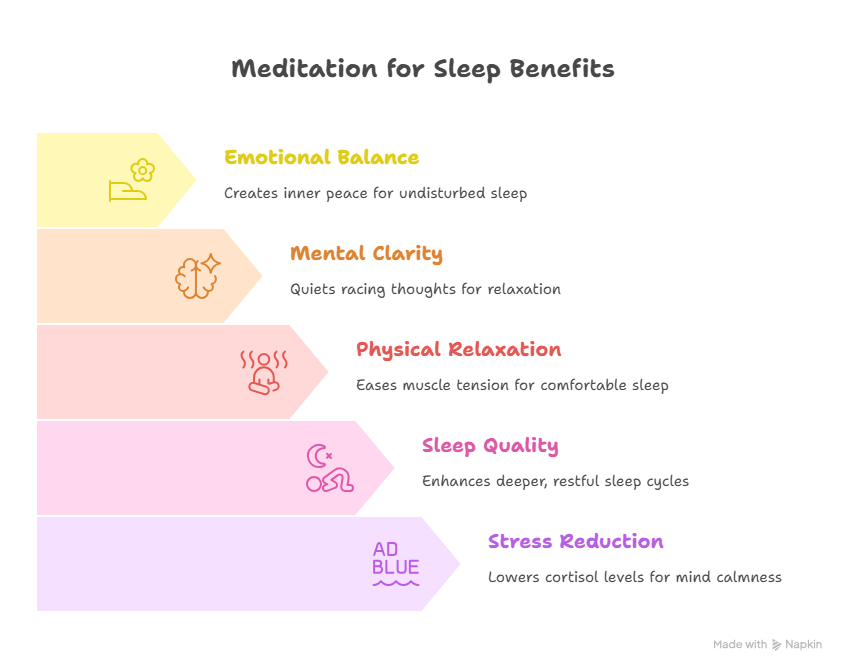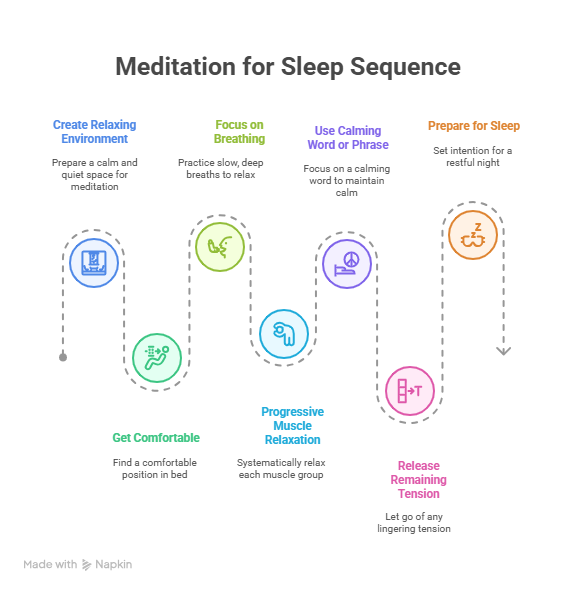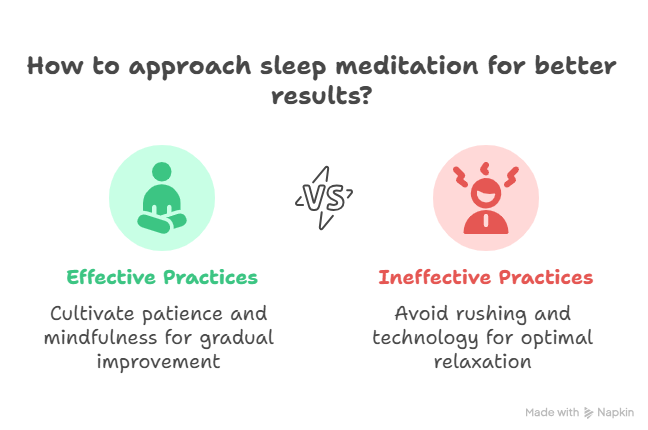Meditation for Sleep: The Ultimate Guide to Better Rest
A good night’s sleep is essential for maintaining overall health and well-being, but many people struggle to achieve it. Whether it’s due to stress, anxiety, or simply a busy mind, falling asleep can often seem like an elusive goal. If you’re struggling to fall asleep at night, you’re not alone. Many people find it difficult to quiet their minds after a busy day, leading to restless nights and sleep deprivation. Fortunately, meditation for sleep offers a simple, natural solution to calm your body and mind, helping you transition into a peaceful slumber. In this guide, we’ll explore what sleep meditation is, its benefits, a step-by-step routine, and helpful tips to improve your sleep quality.
What is Sleep Meditation?
Sleep meditation is a relaxation practice specifically designed to help calm the body and mind, easing the transition from a busy day into a peaceful sleep. Unlike other forms of meditation that may focus on spiritual awareness or mindfulness, sleep meditation targets relaxation techniques that help reduce mental and physical tension. The practice often includes deep breathing, progressive muscle relaxation, and calming mantras that help to release the stress of the day.
By focusing on stilling the mind and soothing the body, sleep meditation creates an ideal environment for restful sleep. It encourages relaxation and prepares you to let go of the day’s anxieties, allowing sleep to come more naturally and deeply.
Reasons for Sleeplessness
Before exploring the benefits of sleep meditation, it’s helpful to understand some common causes of sleeplessness. A variety of factors can contribute to trouble falling asleep:
- Stress and Anxiety: Worrying about daily tasks, work, or personal issues can leave your mind racing, making it hard to relax.
- Overstimulation: Engaging with technology late into the night or consuming caffeine can disrupt the natural rhythm of your body’s sleep cycle.
- Physical Discomfort: Pain, tension, or an uncomfortable sleeping position can prevent the body from relaxing enough to fall asleep.
- Poor Sleep Hygiene: Inconsistent sleep schedules or an unsuitable sleep environment can interfere with your body’s ability to unwind and rest.
Meditation for sleep directly targets these issues by fostering relaxation, reducing stress, and improving sleep quality over time.
Benefits of Meditation for Sleep
Meditation for sleep offers a wide range of benefits that go beyond just helping you fall asleep faster. Here’s how sleep meditation can improve your overall sleep experience:

- Reduced Stress and Anxiety: Meditation helps lower levels of cortisol, the stress hormone, allowing your mind to calm down before bedtime.
- Improved Sleep Quality: Regular meditation can help you experience deeper, more restful sleep cycles, ensuring you wake up feeling refreshed and energized.
- Physical Relaxation: Sleep meditation can ease muscle tension and relax the body, making it easier to settle into a comfortable sleep.
- Mental Clarity: By quieting racing thoughts, meditation helps clear the mind, allowing you to focus on relaxation and gradually ease into sleep.
- Emotional Balance: Meditation creates a sense of inner peace, reducing emotional stress and supporting more restful, undisturbed sleep.
With consistent practice, meditation can improve both the quantity and quality of your sleep, leading to greater overall health and well-being.
Also Read: Benefits of Meditation on Mind and Body
Step-by-Step Guide to a Sleep Meditation Routine
If you’re new to sleep meditation, don’t worry—getting started is simple. Follow this easy step-by-step guide to incorporate meditation into your nightly routine:
- Create a Relaxing Environment
Begin by preparing your sleep environment. Dim the lights and eliminate distractions like electronics. A quiet, calming atmosphere helps set the stage for relaxation. - Get Comfortable
Find a comfortable position in your bed. Whether lying down or sitting up, make sure your body is supported and relaxed. Close your eyes and take a moment to check in with yourself. - Focus on Your Breathing
Take slow, deep breaths in through your nose, hold for a second, and then exhale through your mouth. Focus on the rhythm of your breath, allowing it to become steady and deep. This slow breathing activates your body’s relaxation response and calms the nervous system. - Progressive Muscle Relaxation
Starting at your toes, slowly relax each part of your body, working your way up to your head. As you breathe out, consciously release any tension from each muscle group, one at a time. This process helps to further relax the body and ease any remaining physical tension. - Use a Calming Word or Phrase
If your mind begins to wander, gently guide your thoughts back to your breath. You may also choose a calming word or phrase like “peace” or “relax” to focus your attention inward and maintain a sense of calm. - Release Remaining Tension
After completing the body scan, take a few moments to notice if any tension remains. Let go of any lingering tightness as you breathe out. Feel yourself becoming heavier and more grounded with each breath. - Prepare for Sleep
Finish your meditation by silently setting the intention for a restful night’s sleep. You can say something like, “I am relaxed, and I am ready to sleep deeply.” Allow your body and mind to naturally transition into sleep, knowing that you’ve created the ideal conditions for rest.

Common Mistakes and How to Avoid Them
As with any new practice, there are a few common mistakes to be aware of when starting sleep meditation:
- Expecting Immediate Results: Meditation is a practice that takes time and patience. Don’t be discouraged if you don’t fall asleep right away. The more regularly you practice, the more effective it will become.
- Rushing the Process: Meditation is about slowing down. Don’t rush through the process in an attempt to fall asleep quickly. Take your time with each step to fully relax your body and mind.
- Using Technology Right Before Bed: Avoid using phones, tablets, or computers right before your meditation session. The blue light from screens can interfere with your natural sleep cycle and hinder your ability to wind down.
- Being Critical of Yourself: If your mind wanders, gently bring your focus back to your breath. Don’t judge yourself for getting distracted. It’s natural for thoughts to arise during meditation, so simply acknowledge them and return to your practice.
Conclusion
Meditation for sleep is a powerful, natural tool for improving your sleep quality. By incorporating relaxation techniques such as deep breathing, progressive muscle relaxation, and calming mantras into your nightly routine, you can quiet your mind and calm your body, making it easier to drift off into a peaceful slumber. With regular practice, meditation can help you experience deeper, more restful sleep, allowing you to wake up feeling refreshed and rejuvenated.
Frequently Asked Questions for Meditation for Sleep
1. What is meditation for sleep?
Meditation for sleep is a relaxation practice that helps calm the mind and relax the body, making it easier to fall asleep and enjoy restorative rest.
2. Can meditation for sleep cure insomnia?
While meditation can improve sleep quality and reduce stress, it may not cure chronic insomnia. If insomnia persists, it’s best to consult a healthcare provider for further assistance.
3. How long should I meditate before bed for the best results?
A 10-20 minute meditation is ideal before bed, though even a short 10-minute session can be effective in helping you relax and fall asleep.
4. Is bedtime meditation suitable for everyone?
Yes, bedtime meditation is suitable for most people. However, if you have specific health concerns or sleep disorders, it’s a good idea to speak with a healthcare provider before starting meditation.
5. Do I need any equipment for sleep meditation?
No, you don’t need any special equipment for sleep meditation. All you need is a quiet, comfortable space, and the intention to relax your body and calm your mind. A calming word or phrase can help guide your focus during the practice.
Related Articles:
Meditation Classes and Webinars
To help spread awareness about the transformative power of meditation, SOS has been holding in-person and online multi-language workshops on meditation and positive living for millions of people worldwide, in over 50 countries and 40 languages.

Learn to Meditate
Learn how to find lasting joy and fulfillment through a simple and effective meditation technique.
These interactive FREE online meditation classes will help you deal with the stress and challenges of daily life.
Add meditation to your daily schedule, and see for yourself the difference it makes in your life.

Spiritual Awareness Series
Take time out of your busy schedule to recharge, rejuvenate, and further your spiritual clarity by participating in these online sessions.
These interactive FREE workshops offer practical tips for developing spiritually, resources for healthy living, strategies for dealing with fear and worry, and techniques for living in the current moment.

Detox the Mind
Inspired by the bestselling book, Detox the Mind, these interactive FREE online workshops will help you deal with the stress and challenges of daily life.
These workshops offer a step-by-step plan, engaging exercises, meditation technique, and practical tips for living a stress free, joyous, and tranquil life.
















